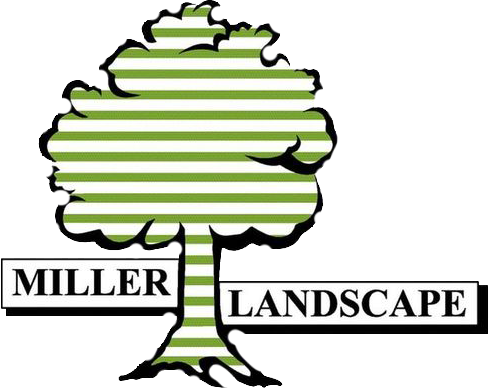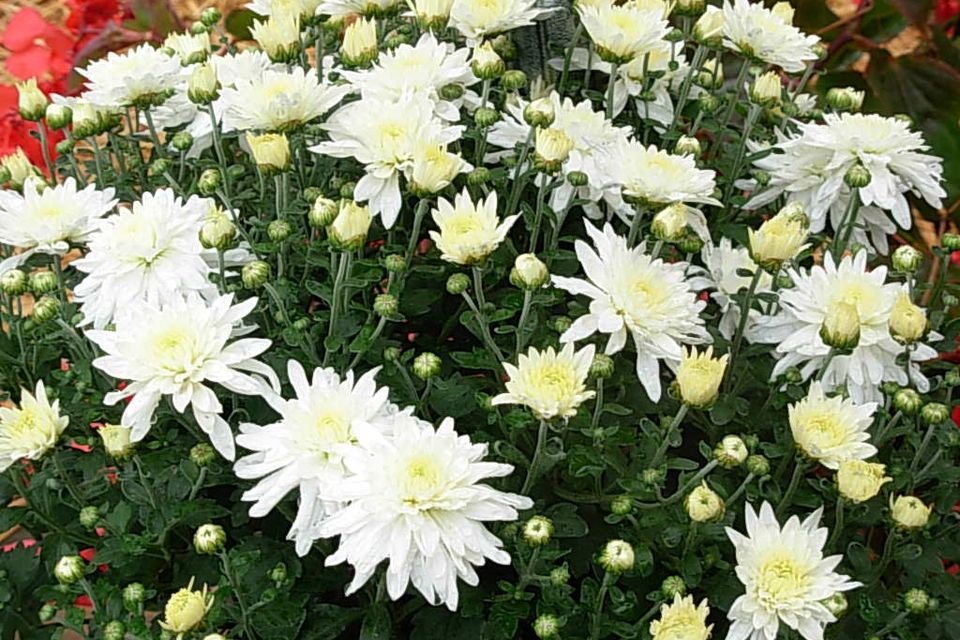
Seasonal Color Displays
Nothing catches the eye like a grouping of well-chosen annuals that flank a building entrance or make a planting bed “pop.” Annuals add sparkle and class to any landscape and we are fortunate to have varieties that can provide three seasons of pleasing visual interest here in Michigan.
The cheerful pansies lead the way in the spring, followed by a full pallet of color and texture provided by the summer annuals. Stately salvia, prolific impatiens, and mounding petunias, properly planted by our crews, can provide months of added enjoyment of your landscape. You can even have us come back in the fall with hardy mums to add clusters of color long after the more tender varieties have ceased blooming. In addition, if you have chosen to have us provide your fall clean-up, we will remove all dead annuals and leave the beds properly prepped for the winter.
The cheerful pansies lead the way in the spring, followed by a full pallet of color and texture provided by the summer annuals. Stately salvia, prolific impatiens, and mounding petunias, properly planted by our crews, can provide months of added enjoyment of your landscape. You can even have us come back in the fall with hardy mums to add clusters of color long after the more tender varieties have ceased blooming. In addition, if you have chosen to have us provide your fall clean-up, we will remove all dead annuals and leave the beds properly prepped for the winter.
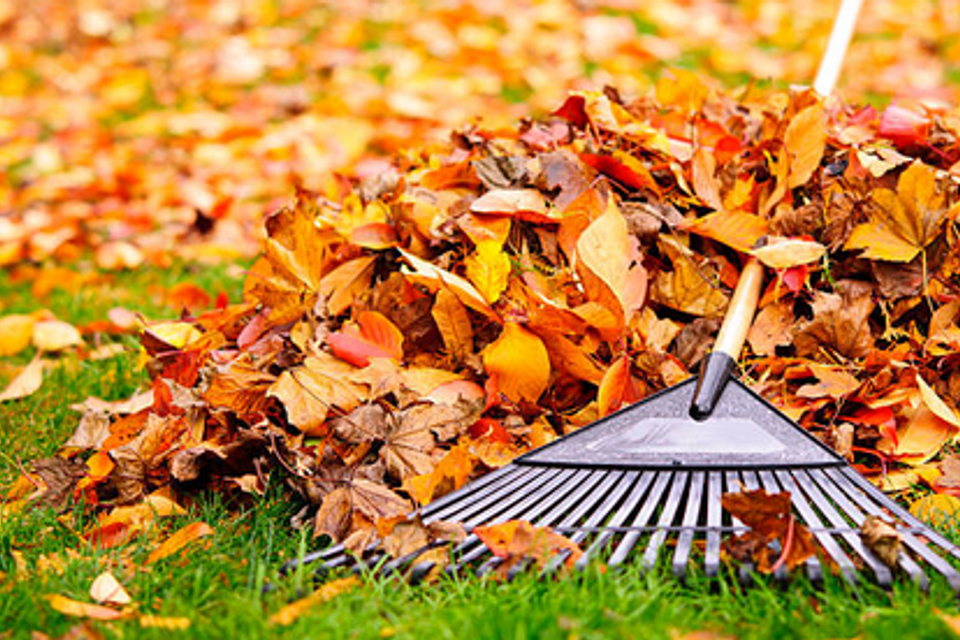
Seasonal Cleanup
A healthy, well maintained landscape requires some extra attention in the spring and fall of the year. As the Michigan seasons change, lawns and planting beds, as well as hard surface areas naturally collect leaves, debris and “spent” plant material.
You need not worry about cutting back perennials, removing dead annuals, raking, bagging and disposing of leaves each fall to prepare your property for our Michigan winters. Our teams simply show up to take care of “the dirty work” with an attention to detail that our commercial and residential customers relish. In the spring, they return to remove any winter debris that has collected, to clear the way for next season’s growth.
We have the specialized equipment and diligent staff to make sure these bi-annual clean-ups are done properly, without encumbering you with the hassle of disposal. We remove everything from the site and recycle all organic materials at our 10 acre location. Our soil shredder and chippers go to work breaking down the debris that the clean-up crews bring back.
You need not worry about cutting back perennials, removing dead annuals, raking, bagging and disposing of leaves each fall to prepare your property for our Michigan winters. Our teams simply show up to take care of “the dirty work” with an attention to detail that our commercial and residential customers relish. In the spring, they return to remove any winter debris that has collected, to clear the way for next season’s growth.
We have the specialized equipment and diligent staff to make sure these bi-annual clean-ups are done properly, without encumbering you with the hassle of disposal. We remove everything from the site and recycle all organic materials at our 10 acre location. Our soil shredder and chippers go to work breaking down the debris that the clean-up crews bring back.
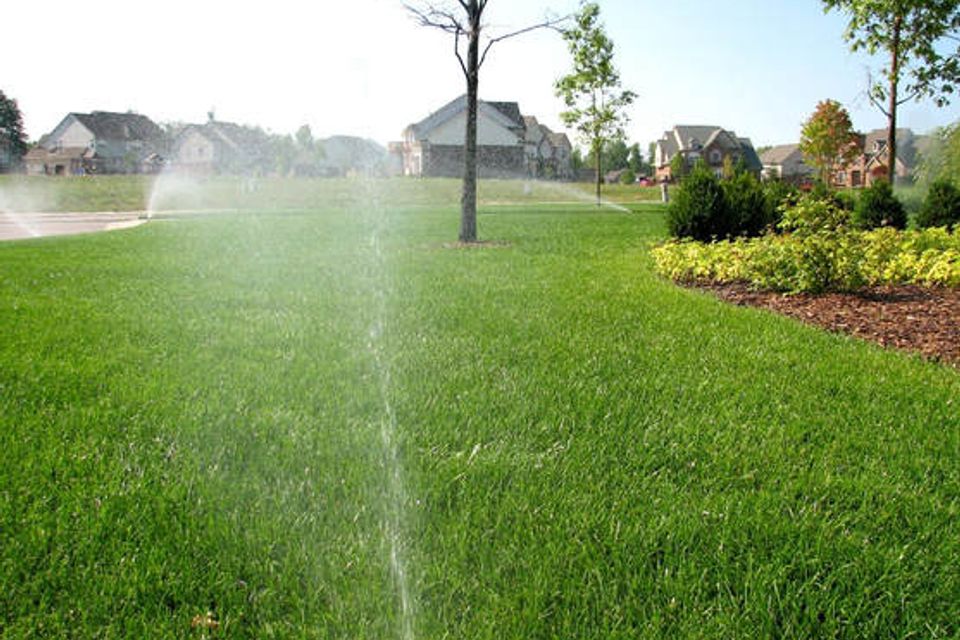
Irrigation Maintenance
Our irrigation system is crucial to the health and beauty of your entire landscape. Proper care of your system protects your investment in both your system and the landscape it nurtures. Miller Landscape has a designated team to manage and maintain every aspect of your sprinkler system here in the great state of Michigan. From the first system turn-on in the spring to the final preparations for winter, we will make sure your sprinkler system is operating at peak performance and maximum efficiency. We will make sure you are honoring local water ordinances while providing the right amount of moisture to your lawn and plants.
We provide irrigation services for residents and commercial sites. We offer our services as a part of a complete landscape maintenance solution, as an irrigation maintenance solution, or on an 'as needed' basis.
Some of the benefits of using one of our yearly maintenance solutions are:
We also offer Irrigation Audits to ensure existing systems are working as efficiently and effectively as possible. Many of maintenance packages will start with an initial audit and it's a great step to take if you're thinking about signing up for a yearly maintenance package. Give us a call and let us know you'd like to discuss your irrigation needs.
We provide irrigation services for residents and commercial sites. We offer our services as a part of a complete landscape maintenance solution, as an irrigation maintenance solution, or on an 'as needed' basis.
Some of the benefits of using one of our yearly maintenance solutions are:
- Automatic scheduling of your spring start-ups and fall shut-downs
[you do not have to remember to call us at the correct time, we have you covered!] - Convenient once per year billing option
- Discounts on parts needed for repairs
- Priority scheduling for repairs and routine maintenance
-
Optional additional maintenance visits to:
- Reset your controller to accommodate seasonal weather changes
- Clean, adjust, and inspect irrigation heads for optimal performance
- Inspect and adjust rain sensors [optional item]
We also offer Irrigation Audits to ensure existing systems are working as efficiently and effectively as possible. Many of maintenance packages will start with an initial audit and it's a great step to take if you're thinking about signing up for a yearly maintenance package. Give us a call and let us know you'd like to discuss your irrigation needs.
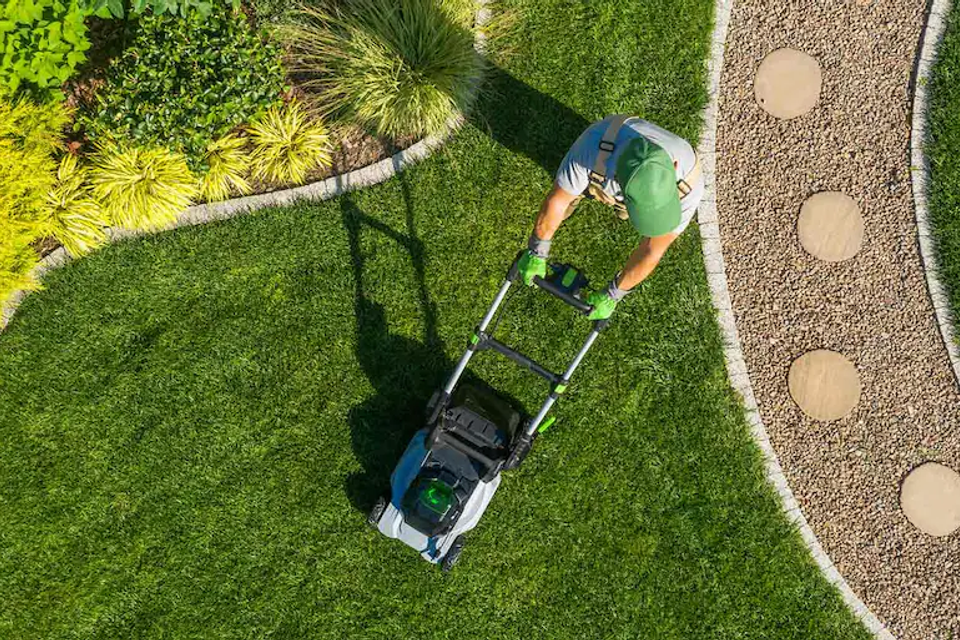
Turf Management
Your lawn is the largest element of the landscape and a major factor in the curb appeal of your home or work place. A healthy, vibrant lawn to "frame" your home and landscape makes driving in the driveway a real joy. Our turf management team is both trained and experienced in delivering top-notch professional lawn care, from the roots up.
Utilizing sound turf management practices and environmentally safe products, we will provide every lawn-related service your property requires in a timely manner. You need not worry about what your lawn may be lacking or when it needs special attention. Your Account Manager will pro-actively "keep an eye out" for possible pest issues, determine the optimal time to fertilize as well as monitor the need to dethatch and aerate for the lasting health of your lawn area. All you need to do is enjoy the moments you can go barefoot!
De-thatching
Thatch [a layer of slowly decomposing grass, dead roots and yard debris] accumulates in all lawns, over time. When the thatch layer becomes too thick, water, air and nutrients can not penetrate it and get into the soil. The roots of your grass suffer, the lower portions of the blades turn brown, the lawn dries out faster, and insects and turf diseases have a “sanctuary” in which to breed. Heavy snowfalls, like we experience in many winters, can compound the problem by increasing instances of “snow mold.”
Not unlike grooming your pet's coat, our machines will deep rake the thatch from your lawn and leave it perfectly prepped for next season's lush growth.
Lawn Aeration
Miller Landscape strongly recommends annual aeration for vibrant, healthy lawns. Aeration reduces compaction which is a condition in which soil is "smashed" tightly together, making it difficult for water, air, nutrients, and the roots of your grass to get down into the dirt. Compaction can be caused by a several things – excessive traffic, hard rainfalls, rainfalls that cause flooding and/or standing water (forcing all the oxygen out of the soil,) sodium in your city water, or just by the type of soil you have. (So many of us are "blessed" with Michigan clay!)
The process of lawn aeration loosens the soil and allows air, water, and nutrients to penetrate and therefore allow the roots of your grass to proliferate more easily. Miller Landscape provides core aeration for your lawn areas, which means we use a machine to remove “plugs” of lawn that are ½” - ¾ “ in depth. As the soil naturally expands to fill the holes over a few weeks’ time, the surrounding soil is allowed to loosen, reducing the overall compaction of the soil. The plugs that are scattered on the lawn eventually break down to form a valuable top dressing that enriches the soil near the surface and helps break down thatch. This service is usually provided in the fall. Aeration increases the effectiveness of your watering because the water will be able to soak into your lawn more easily. (If you notice that water is running off your lawn when you’re watering, this may be a sign that you need to aerate, which could save you money on your water bill!)
Benefits of aeration include:
• Reduced soil compaction
• Improved water penetration
• Improved air exchange between the soil and atmosphere
• Improved fertilizer uptake and usage
• Reduced water runoff and puddling
• Improved rooting
• Improved resiliency and cushioning
• Enhanced thatch breakdown
Utilizing sound turf management practices and environmentally safe products, we will provide every lawn-related service your property requires in a timely manner. You need not worry about what your lawn may be lacking or when it needs special attention. Your Account Manager will pro-actively "keep an eye out" for possible pest issues, determine the optimal time to fertilize as well as monitor the need to dethatch and aerate for the lasting health of your lawn area. All you need to do is enjoy the moments you can go barefoot!
De-thatching
Thatch [a layer of slowly decomposing grass, dead roots and yard debris] accumulates in all lawns, over time. When the thatch layer becomes too thick, water, air and nutrients can not penetrate it and get into the soil. The roots of your grass suffer, the lower portions of the blades turn brown, the lawn dries out faster, and insects and turf diseases have a “sanctuary” in which to breed. Heavy snowfalls, like we experience in many winters, can compound the problem by increasing instances of “snow mold.”
Not unlike grooming your pet's coat, our machines will deep rake the thatch from your lawn and leave it perfectly prepped for next season's lush growth.
Lawn Aeration
Miller Landscape strongly recommends annual aeration for vibrant, healthy lawns. Aeration reduces compaction which is a condition in which soil is "smashed" tightly together, making it difficult for water, air, nutrients, and the roots of your grass to get down into the dirt. Compaction can be caused by a several things – excessive traffic, hard rainfalls, rainfalls that cause flooding and/or standing water (forcing all the oxygen out of the soil,) sodium in your city water, or just by the type of soil you have. (So many of us are "blessed" with Michigan clay!)
The process of lawn aeration loosens the soil and allows air, water, and nutrients to penetrate and therefore allow the roots of your grass to proliferate more easily. Miller Landscape provides core aeration for your lawn areas, which means we use a machine to remove “plugs” of lawn that are ½” - ¾ “ in depth. As the soil naturally expands to fill the holes over a few weeks’ time, the surrounding soil is allowed to loosen, reducing the overall compaction of the soil. The plugs that are scattered on the lawn eventually break down to form a valuable top dressing that enriches the soil near the surface and helps break down thatch. This service is usually provided in the fall. Aeration increases the effectiveness of your watering because the water will be able to soak into your lawn more easily. (If you notice that water is running off your lawn when you’re watering, this may be a sign that you need to aerate, which could save you money on your water bill!)
Benefits of aeration include:
• Reduced soil compaction
• Improved water penetration
• Improved air exchange between the soil and atmosphere
• Improved fertilizer uptake and usage
• Reduced water runoff and puddling
• Improved rooting
• Improved resiliency and cushioning
• Enhanced thatch breakdown
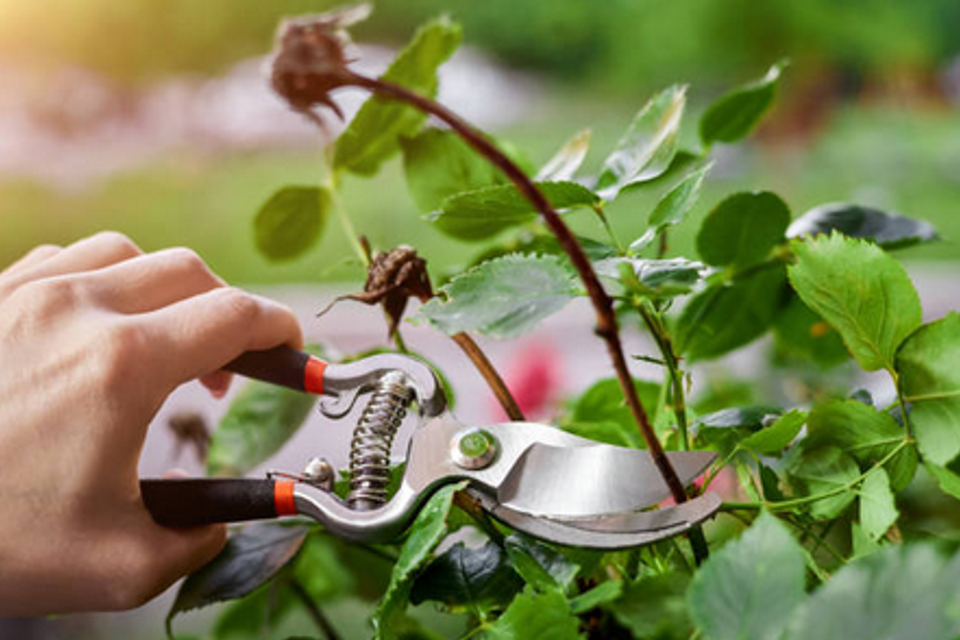
Pruning
Although it may appear to be a simple task, proper pruning requires knowledge of a plant’s natural characteristics, skill, an eye for balance and the correct implements. [A dull set of pruners makes cuts that are far more difficult for the plant to heal.]
When you have Miller Landscape prune your plant material, you can trust that it will be done at an optimal time of year, by trained staff who will groom your landscape with care and precision.
Different plants should be pruned at different times of the year. For example, plants grown mainly for their colorful foliage such as burning bush and barberry should be pruned in early spring before new growth emerges while early flowering plants, such as lilac and cherry trees, should be pruned after they finish flowering. Crab apple trees should be pruned in late winter to reduce risk of infection and disease.
Most spruce and fir trees can be pruned in late winter. Pine trees, such as our state tree the white pine, should be pruned after new growth has emerged. You should only prune new growth back about two-thirds of the way. Pine tree limbs will stop growing outward if you trim the "growing tip" off of the branches.
The necessity for pruning is greatly reduced when the plants are properly chosen for their location in the landscape. Our horticultural specialists have years of experience with plant placement and growing characteristics. We can determine the best pruning options for your plants and make recommendations to remove and relocate plants if needed.
When you have Miller Landscape prune your plant material, you can trust that it will be done at an optimal time of year, by trained staff who will groom your landscape with care and precision.
Different plants should be pruned at different times of the year. For example, plants grown mainly for their colorful foliage such as burning bush and barberry should be pruned in early spring before new growth emerges while early flowering plants, such as lilac and cherry trees, should be pruned after they finish flowering. Crab apple trees should be pruned in late winter to reduce risk of infection and disease.
Most spruce and fir trees can be pruned in late winter. Pine trees, such as our state tree the white pine, should be pruned after new growth has emerged. You should only prune new growth back about two-thirds of the way. Pine tree limbs will stop growing outward if you trim the "growing tip" off of the branches.
The necessity for pruning is greatly reduced when the plants are properly chosen for their location in the landscape. Our horticultural specialists have years of experience with plant placement and growing characteristics. We can determine the best pruning options for your plants and make recommendations to remove and relocate plants if needed.
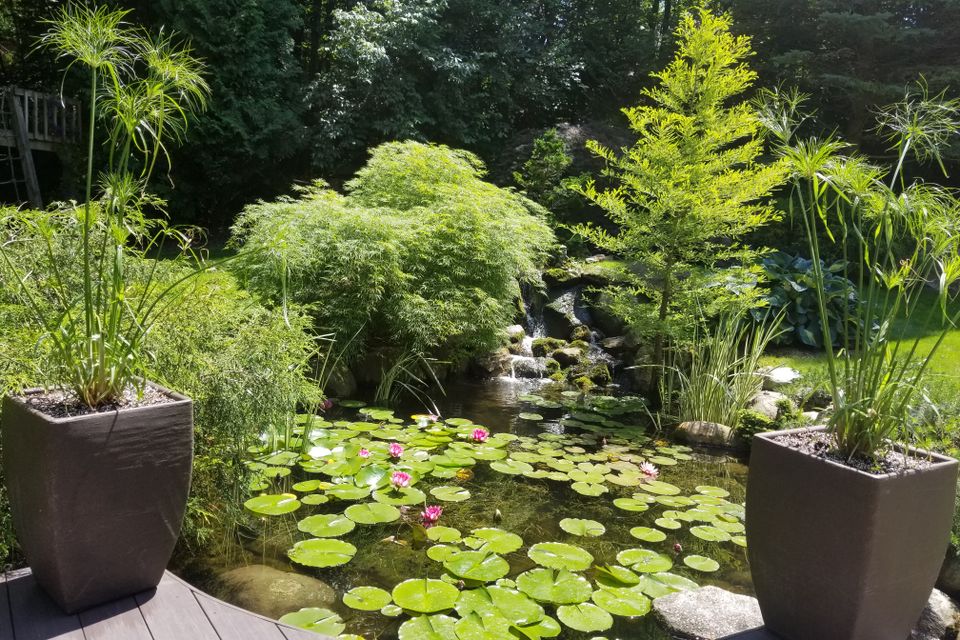
Pond & Water Feature Maintenance
Whenever the unique allure of water is being incorporated into your landscape, there are some basic maintenance requirements that must be met. Similar to a swimming pool or hot tub, there are important tasks that need to be completed, particularly in the spring and fall, in order to keep your water feature clean, functioning properly and attractive.
Our customers with water feature maintenance agreements know that our team will arrive in the spring to clean out all the organic matter that naturally accumulates over a Michigan winter. They then pump all the water out [taking good care of any fish that have been over-wintered] and check the pump, lines and any underwater lighting fixtures you may have. Then they start the water feature up for the season, so that you can just view it with pleasure until the late fall weather beckons the team back to winterize.
Winterization of water features is done in a variety of ways, depending on if there are fish involved. Stand-alone fountains and pond-less waterfalls are simply cleaned, drained and have the pumps shut off. If you enjoy the miniature eco-system of a full-blown pond, our team will discuss your options for making sure your fish are well provided for in their home under the ice.
We can even arrange to come out regularly, during the season, to keep your water feature looking pristine, every day, without you having to lift a finger [or a net!]
Our customers with water feature maintenance agreements know that our team will arrive in the spring to clean out all the organic matter that naturally accumulates over a Michigan winter. They then pump all the water out [taking good care of any fish that have been over-wintered] and check the pump, lines and any underwater lighting fixtures you may have. Then they start the water feature up for the season, so that you can just view it with pleasure until the late fall weather beckons the team back to winterize.
Winterization of water features is done in a variety of ways, depending on if there are fish involved. Stand-alone fountains and pond-less waterfalls are simply cleaned, drained and have the pumps shut off. If you enjoy the miniature eco-system of a full-blown pond, our team will discuss your options for making sure your fish are well provided for in their home under the ice.
We can even arrange to come out regularly, during the season, to keep your water feature looking pristine, every day, without you having to lift a finger [or a net!]
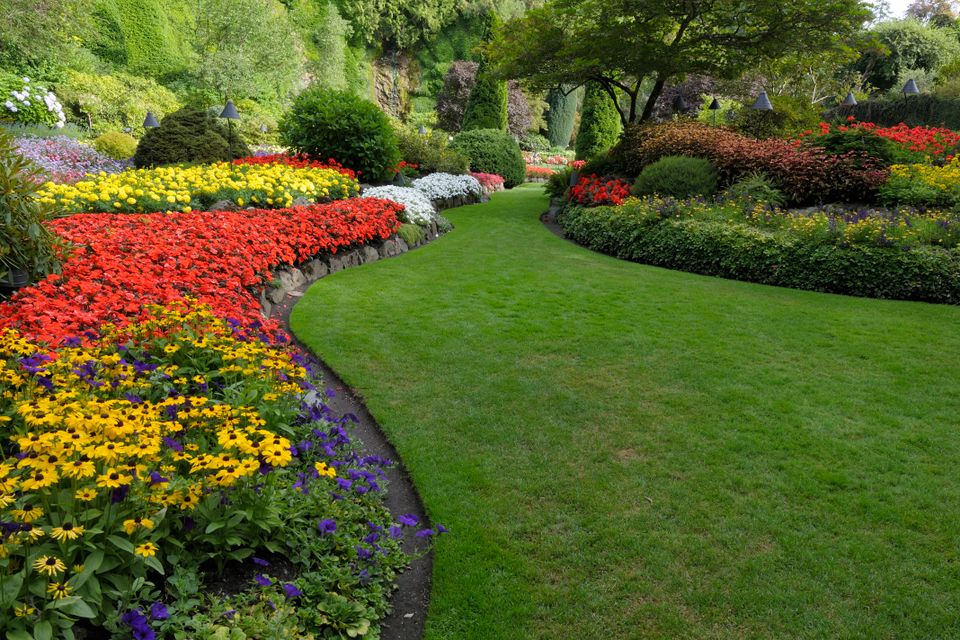
Garden Bed Maintenace
As the ground thaws in the early spring months, it is not only the prized perennials that begin to emerge. The weed population begins to germinate and spread their root systems to vie for their share of space, nutrients and sunlight. Pro-active planting bed maintenance is truly a mainstay for a vibrant, healthy landscape.
Weeding is a tedious, often frustrating job. Spare your knees and have Miller Landscape maintain your beds! We carefully treat your planting areas early to discourage weed growth, and then take care of the ones that invariably pop through. You tell us how often you would like it done, depending on how weed-free you want your property to be. Our staff suggests monthly bed maintenance visits. A fresh layer of double-ground mulch and a professional edging will make your beds a joy to view, from both inside and out.
The Merits of Mulch
The merits of mulching your planting beds are many, especially when you utilize organic mulch. Organic mulch, when applied correctly, benefits your landscape in the following ways:
With our focus on environmental responsibility, Miller Landscape has invested in extensive recycling equipment that enables us to produce our own high quality, double-ground, organic mulch. We even have state-of-the-art equipment to "blow" the mulch into your beds so that you end up with a nice, even depth and no wheelbarrow damage to your lawn or plants!
Of course, we can provide any type of mulch you may choose and we can also deliver mulch to your driveway if you would rather spread it yourself. Either way, mulch is a valuable and attractive addition to any landscape.
Weeding is a tedious, often frustrating job. Spare your knees and have Miller Landscape maintain your beds! We carefully treat your planting areas early to discourage weed growth, and then take care of the ones that invariably pop through. You tell us how often you would like it done, depending on how weed-free you want your property to be. Our staff suggests monthly bed maintenance visits. A fresh layer of double-ground mulch and a professional edging will make your beds a joy to view, from both inside and out.
The Merits of Mulch
The merits of mulching your planting beds are many, especially when you utilize organic mulch. Organic mulch, when applied correctly, benefits your landscape in the following ways:
- Conserves moisture in the soil by decreasing water loss
- Provides a manicured look to the landscape
- Reduces soil erosion
- Minimizes weed germination and growth
[especially when you have our team pre-treat your planting
beds with a pre-emergent product] - Helps to moderate the temperature of the soil
[the roots of your plants will thank you in summer and winter!] - Adds nutrients to the soil following decomposition
With our focus on environmental responsibility, Miller Landscape has invested in extensive recycling equipment that enables us to produce our own high quality, double-ground, organic mulch. We even have state-of-the-art equipment to "blow" the mulch into your beds so that you end up with a nice, even depth and no wheelbarrow damage to your lawn or plants!
Of course, we can provide any type of mulch you may choose and we can also deliver mulch to your driveway if you would rather spread it yourself. Either way, mulch is a valuable and attractive addition to any landscape.
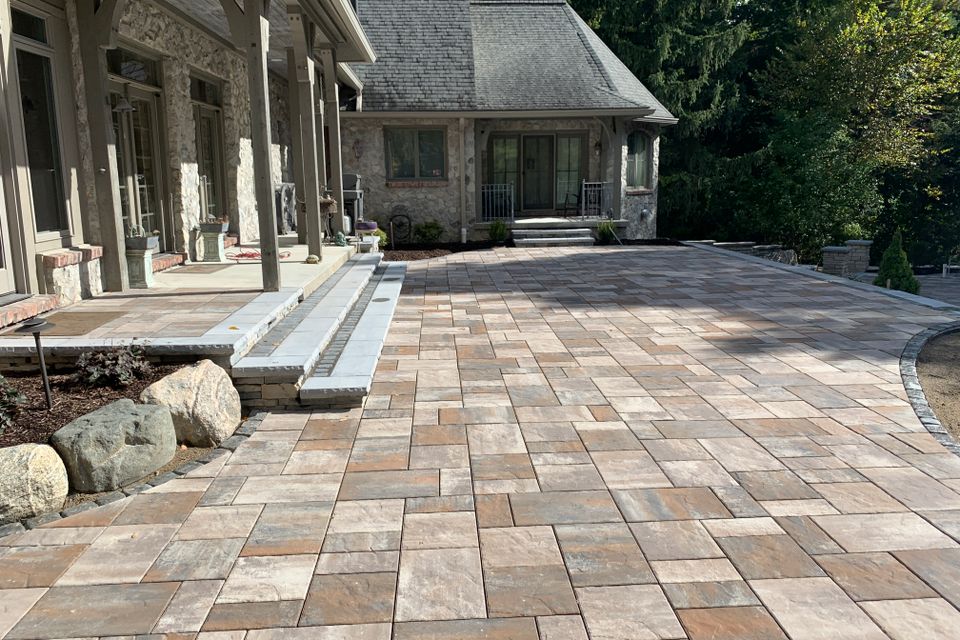
Paver Sealing & Repair
Concrete pavers get their color by adding pigment to cement. Over time, the surface does wear down from traffic and weather, causing a gradual change in color. Sealing your concrete pavers can prevent not only fading of color, but also accumulation of dirt. Sealing your concrete pavers will also ensure easier surface cleaning and enhance the existing color.
Miller Landscape is pleased to offer you a way to protect your pavers [and your investment] with a sealing process that will:
Miller Landscape is pleased to offer you a way to protect your pavers [and your investment] with a sealing process that will:
- Highlight the original color and warmth of your pavers’ pattern
- Help deter the growth of weeds and moss in the joints
- Increase resistance to grease and oil stains
- Offer you a choice of either a natural or high luster [“wet look”] finish
- Provide fresh, new look for your patio or walkway
Since proper sealing involves special cleaning, preparation and coating of your pavers, we invested in the professional certification of several of our team members who have completed the training and exams required to become Certified Applicators of Techniseal products. Techniseal manufactures the finest of paver cleaning and sealing products in the world. We are proud to be one of only 4 companies in Southeast Michigan to be trained and certified by Techniseal.
This is the process our team will follow to provide a “face lift” for your paver patios and walkways:
- First, they remove oil, rust and other stains [if possible] from your pavers
- Next, they clean them thoroughly with Techniseal Efflorescence or Hardscape Cleaners. [Efflorescence is a white residue caused by lime released within concrete pavers. It does not always occur and it does not damage the paver, but most of our customers prefer to have it removed for “cosmetic” reasons.]
- Finally, the team applies long-lasting, highly regarded, Techniseal paver protection in either a mat or satin finish. This sealant won’t peel or turn yellow and it resists calcium.
Additional Paver Care
When you choose to have your pavers professionally cleaned and sealed by Miller Landscape, you will also have the option of having our crews replace your existing joint sand with Polymeric Joint Sand. This is an advanced sand product that locks in place because it is a special mixture of calibrated natural sand and flexible binders that stays within joints better than any other type of sand.
Polymeric Joint Sand:
- Resists erosion
- Inhibits weed growth
- Deters ants and other insects
- Stabilizes pavers
- Is perfect for repairing both narrow and wide joints
In terms of maintaining your pavers yourself, we offer the following tips.
Oil stains will not damage your pavers, but they can prove difficult to remove. Treat them as soon as possible by wiping the excess oil from the surface and washing them with a mild detergent and hot water. With stubborn stains you may need to do this several times. In a case where you simply cannot get a paver clean, replacing it may be the best solution. Pavers are made to be removed easily in just such a case. Again, sealing your pavers can also assist in managing stains.
Sometimes, weeds will appear in the joints of your pavers. Unfortunately, there is no way to completely eliminate this from happening. There are, however, a couple of preventative measures you can take. Sealing your pavers and the use of Polymeric Joint Sand are the easiest solutions for keeping weeds at bay. The use of an herbicide such as Roundup® applied directly to the joints can also significantly decrease the amount of weeds that grow and will not stain or harm your pavers
We would also be happy to do any paver repairs you may need done. Perhaps you have an area that has settled [with the help of chipmunks!] or a step that has loosened over time? Give us a call and we will be happy to provide a proposal for “touching up” and protecting your paver investment.
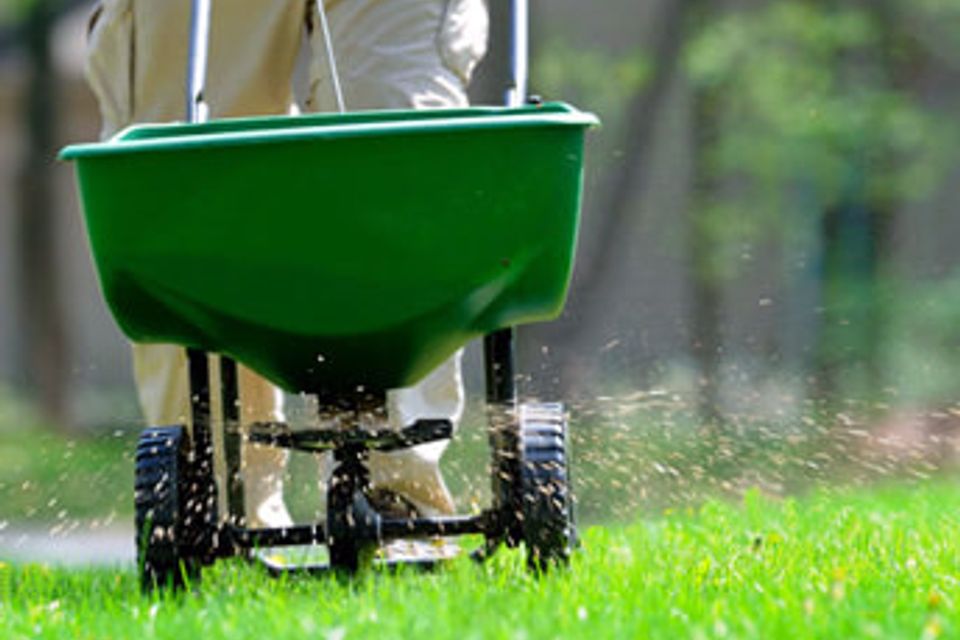
Fertilizing, Weed & Pest Control
Lawns are comprised of millions of individual plants, each craving the proper amount of water, nutrients and sunlight to thrive. The health of your lawn areas is critical to the overall appearance of your landscape and it is our mission to provide optimal care for your lawn areas.
In order to achieve a healthy, lush, deep green lawn it is important to apply the correct fertilizers and weed control products at the right time of the year. Invasive weeds crowd grass and steal valuable nutrients, water and sunlight from your lawn.
In order to achieve a healthy, lush, deep green lawn it is important to apply the correct fertilizers and weed control products at the right time of the year. Invasive weeds crowd grass and steal valuable nutrients, water and sunlight from your lawn.
By providing proper care, we can make your lawn so thick that it discourages infestation of dandelions, crabgrass, and other noxious weeds. The best defense against pest problems in your lawn is to have a healthy lawn. Healthy lawns naturally defend themselves against pests. As an added level of protection, our Certified Pesticide Applicators are well equipped to manage any pest invasions that may occur. Individual site requirements and personal preferences dictate the exact products we use at each customer's location. Whether you are interested in organic treatments, lake-friendly treatments, or traditional chemical treatments, we have a solution to make sure your lawn is looking and growing its best. With Miller Landscape, your grass can be the grass on the other side of the fence that really IS greener!
Crabgrass Control and Prevention
Crabgrass is a stubborn lawn weed. It is much more difficult to treat and kill live plants than it is to prevent them, so prevention is key. Crabgrass grows and spreads from seed. If the seeds aren't there or they don't germinate, then your lawn will be free from crabgrass. So, once you've gotten rid of the crabgrass, it becomes less of a problem to deal with.
Pre-Emergent Herbicides are the best chemical control available. They work by preventing the germination of the crabgrass seeds. If you are seeding a new lawn area, wait to use any pre-emergent control as it can stop other grass seeds from germinating as well. Crabgrass gets started in the spring, about two weeks after the bright yellow forsythia blooms have faded. Soil temperatures a few inches below ground will be reaching 55-60 degrees fahrenheit and that is when the seeds will begin germination.
If you time up the pre-emergent application right, your lawn will have little crabgrass to start the spring. New crabgrass will still try to take hold in bare spots along edges and in the lawn. Depending on the amount and location of the crabgrass it may make sense to treat it with a post-emergent crabgrass killer or simply pull it out. If it's late enough in the year, the crabgrass can be left and it will die over the winter.
Treating with a pre-emergent the following spring will take care of the seeds and your lawn will be crabgrass free. If you are looking for chemical free options, crabgrass control is similar to weed control. A long, healthy lawn is the best defense against weeds and crabgrass. A lawn height of 3" or more is ideal. Tall, thick grass will block out the light for other seedlings.
Watering cycles can help too. Adjust irrigation timing to give deep watering cycles, less frequently. Crabgrass roots shallow and seedlings will struggle if they are allowed to dry out between watering. If you are battling with crabgrass and would like us to come take care of it for you, give us a call or talk to your account manager about adding it in to your existing maintenance contract.
Want to learn more? Try the following resources:
Crabgrass Control and Prevention
Crabgrass is a stubborn lawn weed. It is much more difficult to treat and kill live plants than it is to prevent them, so prevention is key. Crabgrass grows and spreads from seed. If the seeds aren't there or they don't germinate, then your lawn will be free from crabgrass. So, once you've gotten rid of the crabgrass, it becomes less of a problem to deal with.
Pre-Emergent Herbicides are the best chemical control available. They work by preventing the germination of the crabgrass seeds. If you are seeding a new lawn area, wait to use any pre-emergent control as it can stop other grass seeds from germinating as well. Crabgrass gets started in the spring, about two weeks after the bright yellow forsythia blooms have faded. Soil temperatures a few inches below ground will be reaching 55-60 degrees fahrenheit and that is when the seeds will begin germination.
If you time up the pre-emergent application right, your lawn will have little crabgrass to start the spring. New crabgrass will still try to take hold in bare spots along edges and in the lawn. Depending on the amount and location of the crabgrass it may make sense to treat it with a post-emergent crabgrass killer or simply pull it out. If it's late enough in the year, the crabgrass can be left and it will die over the winter.
Treating with a pre-emergent the following spring will take care of the seeds and your lawn will be crabgrass free. If you are looking for chemical free options, crabgrass control is similar to weed control. A long, healthy lawn is the best defense against weeds and crabgrass. A lawn height of 3" or more is ideal. Tall, thick grass will block out the light for other seedlings.
Watering cycles can help too. Adjust irrigation timing to give deep watering cycles, less frequently. Crabgrass roots shallow and seedlings will struggle if they are allowed to dry out between watering. If you are battling with crabgrass and would like us to come take care of it for you, give us a call or talk to your account manager about adding it in to your existing maintenance contract.
Want to learn more? Try the following resources:
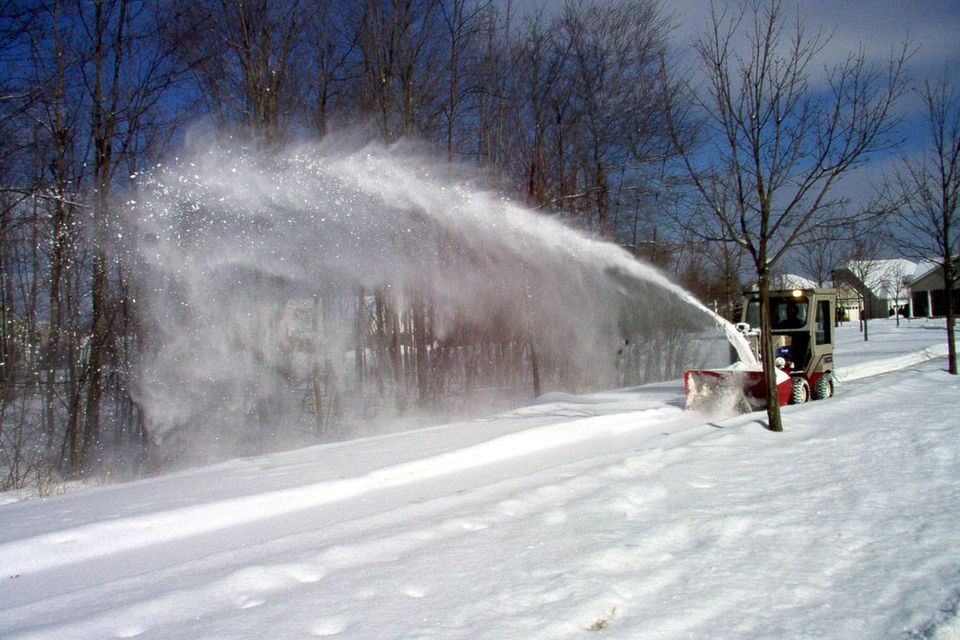
Snow Removal & De-Icing
Snow Removal & De-Icing
Michigan winters can be unpredictable, both year to year and hour to hour. At Miller Landscape we have a team of veteran snow removal experts that proactively monitor changing weather conditions. Whether it's snow, ice, sleet, or freezing rain we are always ready and prepared to handle it.
We have the equipment to handle everything from large commercial and industrial lots to neighborhood streets, sidewalks, and driveways.
We provide snow plowing services, salting and deicing, and snow removal services to commercial and residential customers in south east Michigan.
Call us today or fill out our Request a Quote form to receive an estimate.
We are proud of our experienced team with their “whatever it takes” attitude keeping your driveways, parking lots and walks clear and safe. Our residential customers can sign up for our Evergreen Maintenance Package and receive one monthly payment, one dedicated Account Manager, and one reliable, consistent level of service.
When the snow hits, you don't want to wonder who to call or if they'll show up. You just want things taken care of. We understand, we make it happen, and we do it better than any service provider you've had before.
Michigan winters can be unpredictable, both year to year and hour to hour. At Miller Landscape we have a team of veteran snow removal experts that proactively monitor changing weather conditions. Whether it's snow, ice, sleet, or freezing rain we are always ready and prepared to handle it.
We have the equipment to handle everything from large commercial and industrial lots to neighborhood streets, sidewalks, and driveways.
We provide snow plowing services, salting and deicing, and snow removal services to commercial and residential customers in south east Michigan.
Call us today or fill out our Request a Quote form to receive an estimate.
We are proud of our experienced team with their “whatever it takes” attitude keeping your driveways, parking lots and walks clear and safe. Our residential customers can sign up for our Evergreen Maintenance Package and receive one monthly payment, one dedicated Account Manager, and one reliable, consistent level of service.
When the snow hits, you don't want to wonder who to call or if they'll show up. You just want things taken care of. We understand, we make it happen, and we do it better than any service provider you've had before.
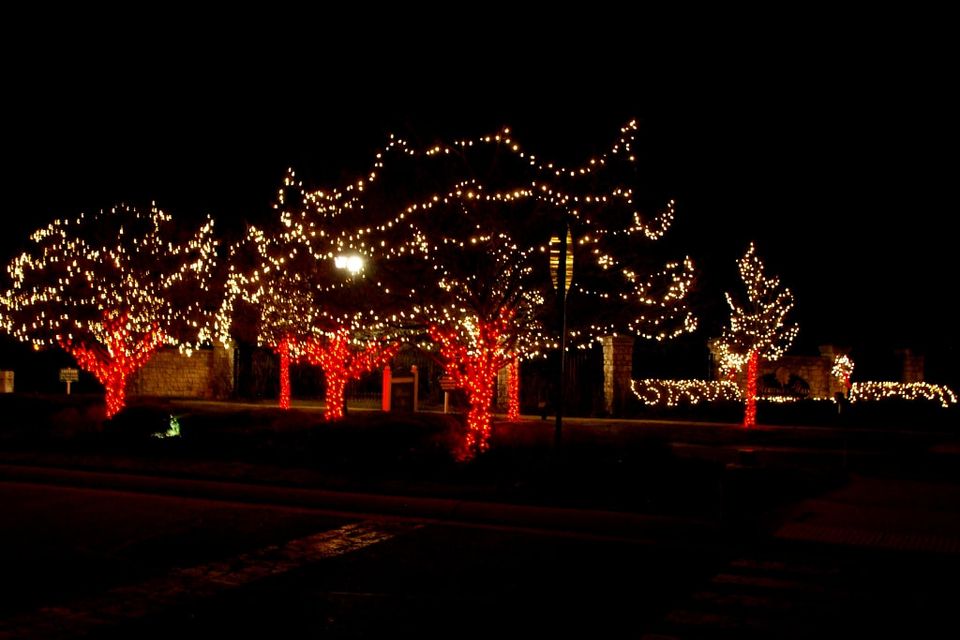
Holiday Lights
Nothing evokes warm and festive holiday feelings like a tastefully designed holiday lighting display. Give yourself a gift this year. Let Miller Landscape take the hassle out of the annual chore of installing and storing holiday lights so that you, your family and your neighbors can simply "enjoy the show."
Our team will:
No more tangled strands, tipsy ladders and frozen hands for you! Call early so that we can arrange an early spot on the schedule for you.
We are proud to be chosen as the Preferred Holiday Lighting Installer for Bordines of Rochester, Bordines of Clarkston as well as Canterbury Village. Look for our signs and flyers when you visit these very popular retailers.
Our team will:
- Install your holiday lights, using your lights or we will provide them. [The new LED lights that we will provide, if you choose, last 20 times longer than traditional holiday lights and are 80% more efficient!]
- Maintain them and take them down in January [weather permitting]
- Inventory and store them for you until next season.
No more tangled strands, tipsy ladders and frozen hands for you! Call early so that we can arrange an early spot on the schedule for you.
We are proud to be chosen as the Preferred Holiday Lighting Installer for Bordines of Rochester, Bordines of Clarkston as well as Canterbury Village. Look for our signs and flyers when you visit these very popular retailers.
